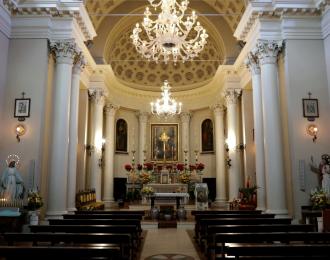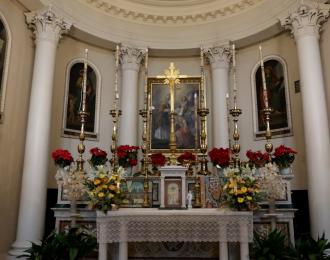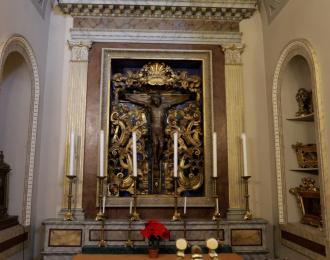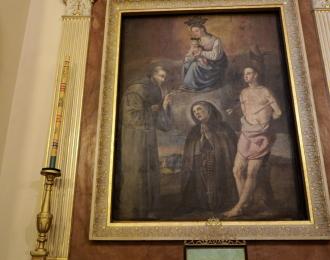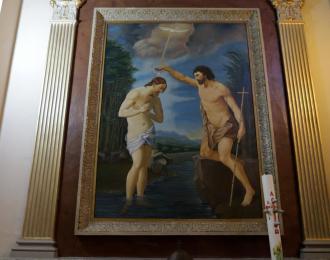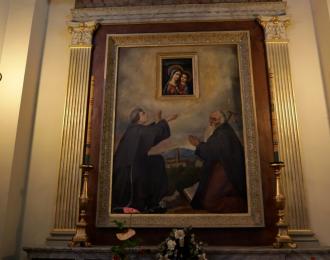Keep and Church of Pope St. Sylvester
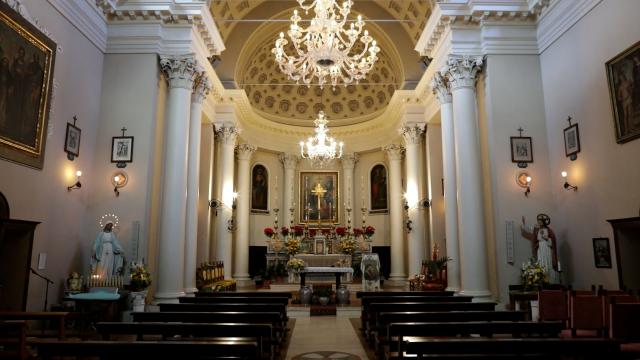
The parish church, dedicated to Pope St. Sylvester is on the highest part of the hill, it is extremely old, maybe prior to the year 1000, although the exact date of its construction is unknown. It was mentioned for the first time in the ‘Rationes decimarum’ of 1275: “Ecclesia Sancti Silvestri de Plagario solvit lib. V sol. XI, den -“. In the estimate of 1444 it is registered for 36 pounds, while in the land registry of 1489 it appears for 65 pounds. From the very beginning it had the title of parish. It was administered by the Camaldolese Benedictine monks of the monastery of St. John the Hermit of Mount Erile, who appointed the parish priest who had to be approved by the bishop. In 1471, as it was transformed from a monastery by Pope Sisto IV into secular commendam, also the church passed under the dependence of the various Commendatory Abbots, who succeeded each other in the government of the Abbey.
Like most churches of ancient origin, also St. Sylvester’s underwent various restorations and renovations over the centuries and one was carried out in 1777 but it did not seriously alter the original plan. In fact, according to the report of the pastoral visit made by Bishop Tommaso Mancini, the church still retained its original layout: rectangular plan with a single nave, a trussed ceiling, comfortable pulpit, small chorus behind the high altar, efficient organ and seven altars. Only in the mid-nineteenth century did the interior of the temple undergo a radical transformation thus assuming its current neoclassical style. The trussed ceiling was replaced by a vault, divided into large geometrical sections, supported by 14 large smooth-stemmed columns and with Corinthian capitals leaning against the walls. The altars from seven were reduced to five. Interior: On the right side of the main entrance is the access door to the bell tower incorporated into the perimeter wall of the building.
Towards 1950, the pulpit located on the right wall was removed and replaced by a 16th century canvas depicting “The Virgin with Child between St. Sebastian and St. Rocco”. The other paintings adorning the side walls of the church are all by unknown artists and date back to the 16th-17th centuries. On the left side below a large semicircular window is a large painting (late 16th century) depicting St. Thomas between St. Peter, St. Paul, St. Cecilia and another unidentified saint. The altar of the Chapel of Relics is surmounted by a large oil on canvas, datable to the late 16th century, depicting the Virgin with Child, St. Francis, St. Sebastian and St. Margaret of Cortona.
In the centre of the apse wall is a large picture with a golden frame showing the Emperor Constantine kneeling before Pope Sylvester, his right hand resting on an open missal supported by an angel; in the background is a luminous cross and the inscription ‘in hoc signo vinces’. On the sides of the canvas are paintings from between 1860 and 1865 by the painter S. Cirinelli and represent the evangelists St. Mark, St. Mathew, St. John and St. Luke. The altar of the Crucifix has a 17th century wooden Christ set in a rich golden decoration, highly venerated by the people of Piegaro, to whom miraculous interventions have always been attributed. In front of the tombstone is an oil painting representing the half-bust of Blessed Paul. Always on the right side, to conclude, there is an altar surmounted by a large painting depicting St. Anthony from Padua and St. Anthony the Abbot. In the space between the two figures, a view of Piegaro castle and above it the image of Our Mother of Good Council. The chapel of Madonna of the Rosary is enriched with two large oil canvasses depicting the Virgin with Child between St. Sylvester and St. Augustan (17th cent.) and the Descent of the Holy Spirit on the Virgin and the Apostles.
